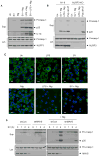The mitochondrial antiviral protein MAVS associates with NLRP3 and regulates its inflammasome activity
- PMID: 24048902
- PMCID: PMC3848201
- DOI: 10.4049/jimmunol.1301170
The mitochondrial antiviral protein MAVS associates with NLRP3 and regulates its inflammasome activity
Abstract
NLRP3 assembles an inflammasome complex that activates caspase-1 upon sensing various danger signals derived from pathogenic infection, tissue damage, and environmental toxins. How NLRP3 senses these various stimuli is still poorly understood, but mitochondria and mitochondrial reactive oxygen species have been proposed to play a critical role in NLRP3 activation. In this article, we provide evidence that the mitochondrial antiviral signaling protein MAVS associates with NLRP3 and facilitates its oligomerization leading to caspase-1 activation. In reconstituted 293T cells, full-length MAVS promoted NLRP3-dependent caspase-1 activation, whereas a C-terminal transmembrane domain-truncated mutant of MAVS (MAVS-ΔTM) did not. MAVS, but not MAVS-ΔTM, interacted with NLRP3 and triggered the oligomerization of NLRP3, suggesting that mitochondrial localization of MAVS and intact MAVS signaling are essential for activating the NLRP3 inflammasome. Supporting this, activation of MAVS signaling by Sendai virus infection promoted NLRP3-dependent caspase-1 activation, whereas knocking down MAVS expression clearly attenuated the activation of NLRP3 inflammasome by Sendai virus in THP-1 and mouse macrophages. Taken together, our results suggest that MAVS facilitates the recruitment of NLRP3 to the mitochondria and may enhance its oligomerization and activation by bringing it in close proximity to mitochondrial reactive oxygen species.
Figures






Similar articles
-
Cytosolic double-stranded RNA activates the NLRP3 inflammasome via MAVS-induced membrane permeabilization and K+ efflux.J Immunol. 2014 Oct 15;193(8):4214-4222. doi: 10.4049/jimmunol.1400582. Epub 2014 Sep 15. J Immunol. 2014. PMID: 25225670 Free PMC article.
-
Non-transcriptional regulation of NLRP3 inflammasome signaling by IL-4.Immunol Cell Biol. 2015 Jul;93(6):591-9. doi: 10.1038/icb.2014.125. Epub 2015 Jan 20. Immunol Cell Biol. 2015. PMID: 25601272 Free PMC article.
-
Sendai Virus V Protein Inhibits the Secretion of Interleukin-1β by Preventing NLRP3 Inflammasome Assembly.J Virol. 2018 Sep 12;92(19):e00842-18. doi: 10.1128/JVI.00842-18. Print 2018 Oct 1. J Virol. 2018. PMID: 30021903 Free PMC article.
-
Initiation and perpetuation of NLRP3 inflammasome activation and assembly.Immunol Rev. 2015 May;265(1):35-52. doi: 10.1111/imr.12286. Immunol Rev. 2015. PMID: 25879282 Free PMC article. Review.
-
Molecular mechanism of NLRP3 inflammasome activation.J Clin Immunol. 2010 Sep;30(5):628-31. doi: 10.1007/s10875-010-9440-3. Epub 2010 Jun 30. J Clin Immunol. 2010. PMID: 20589420 Review.
Cited by
-
RIG-I in RNA virus recognition.Virology. 2015 May;479-480:110-21. doi: 10.1016/j.virol.2015.02.017. Epub 2015 Mar 5. Virology. 2015. PMID: 25749629 Free PMC article. Review.
-
Beclin-1 improves mitochondria-associated membranes in the heart during endotoxemia.FASEB Bioadv. 2021 Jan 25;3(3):123-135. doi: 10.1096/fba.2020-00039. eCollection 2021 Mar. FASEB Bioadv. 2021. PMID: 33733054 Free PMC article.
-
Cell Death Is Counteracted by Mitophagy in HIV-Productively Infected Astrocytes but Is Promoted by Inflammasome Activation Among Non-productively Infected Cells.Front Immunol. 2018 Nov 20;9:2633. doi: 10.3389/fimmu.2018.02633. eCollection 2018. Front Immunol. 2018. PMID: 30515154 Free PMC article.
-
New Insights into the Crosstalk among the Interferon and Inflammatory Signaling Pathways in Response to Viral Infections: Defense or Homeostasis.Viruses. 2022 Dec 15;14(12):2798. doi: 10.3390/v14122798. Viruses. 2022. PMID: 36560803 Free PMC article. Review.
-
Investigation of MicroRNA in Mitochondrial Apoptotic Pathway in Systemic Lupus Erythematosus.Biomed Res Int. 2018 Jul 10;2018:9026357. doi: 10.1155/2018/9026357. eCollection 2018. Biomed Res Int. 2018. PMID: 30105262 Free PMC article.
References
-
- Tschopp J, Schroder K. NLRP3 inflammasome activation: The convergence of multiple signalling pathways on ROS production? Nat Rev Immunol. 2010;10:210–215. - PubMed
-
- Strowig T, Henao-Mejia J, Elinav E, Flavell R. Inflammasomes in health and disease. Nature. 2012;481:278–286. - PubMed
-
- Aksentijevich I, DP C, Remmers EF, Mueller JL, Le J, Kolodner RD, Moak Z, Chuang M, Austin F, Goldbach-Mansky R, Hoffman HM, Kastner DL. The clinical continuum of cryopyrinopathies: novel CIAS1 mutations in North American patients and a new cryopyrin model. Arthritis Rheum. 2007;56:1273–1285. - PMC - PubMed
Publication types
MeSH terms
Substances
Grants and funding
LinkOut - more resources
Full Text Sources
Other Literature Sources
Miscellaneous

